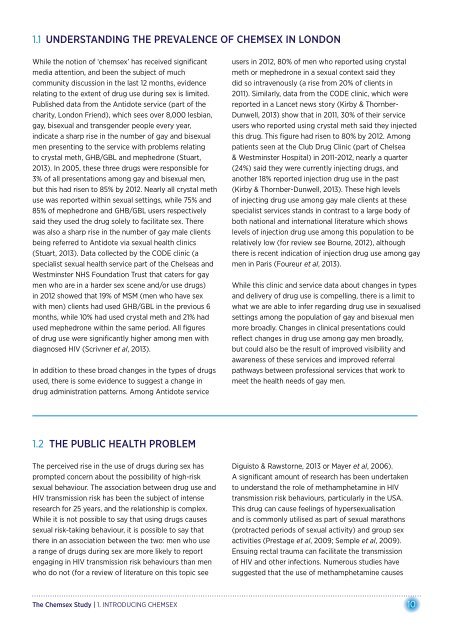ssh-chemsex-study-final-main-report
ssh-chemsex-study-final-main-report
ssh-chemsex-study-final-main-report
Create successful ePaper yourself
Turn your PDF publications into a flip-book with our unique Google optimized e-Paper software.
1.1 UNDERSTANDING THE PREVALENCE OF CHEMSEX IN LONDON<br />
While the notion of ‘<strong>chemsex</strong>’ has received significant<br />
media attention, and been the subject of much<br />
community discussion in the last 12 months, evidence<br />
relating to the extent of drug use during sex is limited.<br />
Published data from the Antidote service (part of the<br />
charity, London Friend), which sees over 8,000 lesbian,<br />
gay, bisexual and transgender people every year,<br />
indicate a sharp rise in the number of gay and bisexual<br />
men presenting to the service with problems relating<br />
to crystal meth, GHB/GBL and mephedrone (Stuart,<br />
2013). In 2005, these three drugs were responsible for<br />
3% of all presentations among gay and bisexual men,<br />
but this had risen to 85% by 2012. Nearly all crystal meth<br />
use was <strong>report</strong>ed within sexual settings, while 75% and<br />
85% of mephedrone and GHB/GBL users respectively<br />
said they used the drug solely to facilitate sex. There<br />
was also a sharp rise in the number of gay male clients<br />
being referred to Antidote via sexual health clinics<br />
(Stuart, 2013). Data collected by the CODE clinic (a<br />
specialist sexual health service part of the Chelseas and<br />
Westminster NHS Foundation Trust that caters for gay<br />
men who are in a harder sex scene and/or use drugs)<br />
in 2012 showed that 19% of MSM (men who have sex<br />
with men) clients had used GHB/GBL in the previous 6<br />
months, while 10% had used crystal meth and 21% had<br />
used mephedrone within the same period. All figures<br />
of drug use were significantly higher among men with<br />
diagnosed HIV (Scrivner et al, 2013).<br />
In addition to these broad changes in the types of drugs<br />
used, there is some evidence to suggest a change in<br />
drug administration patterns. Among Antidote service<br />
users in 2012, 80% of men who <strong>report</strong>ed using crystal<br />
meth or mephedrone in a sexual context said they<br />
did so intravenously (a rise from 20% of clients in<br />
2011). Similarly, data from the CODE clinic, which were<br />
<strong>report</strong>ed in a Lancet news story (Kirby & Thornber-<br />
Dunwell, 2013) show that in 2011, 30% of their service<br />
users who <strong>report</strong>ed using crystal meth said they injected<br />
this drug. This figure had risen to 80% by 2012. Among<br />
patients seen at the Club Drug Clinic (part of Chelsea<br />
& Westminster Hospital) in 2011-2012, nearly a quarter<br />
(24%) said they were currently injecting drugs, and<br />
another 18% <strong>report</strong>ed injection drug use in the past<br />
(Kirby & Thornber-Dunwell, 2013). These high levels<br />
of injecting drug use among gay male clients at these<br />
specialist services stands in contrast to a large body of<br />
both national and international literature which shows<br />
levels of injection drug use among this population to be<br />
relatively low (for review see Bourne, 2012), although<br />
there is recent indication of injection drug use among gay<br />
men in Paris (Foureur et al, 2013).<br />
While this clinic and service data about changes in types<br />
and delivery of drug use is compelling, there is a limit to<br />
what we are able to infer regarding drug use in sexualised<br />
settings among the population of gay and bisexual men<br />
more broadly. Changes in clinical presentations could<br />
reflect changes in drug use among gay men broadly,<br />
but could also be the result of improved visibility and<br />
awareness of these services and improved referral<br />
pathways between professional services that work to<br />
meet the health needs of gay men.<br />
1.2 THE PUBLIC HEALTH PROBLEM<br />
The perceived rise in the use of drugs during sex has<br />
prompted concern about the possibility of high-risk<br />
sexual behaviour. The association between drug use and<br />
HIV transmission risk has been the subject of intense<br />
research for 25 years, and the relationship is complex.<br />
While it is not possible to say that using drugs causes<br />
sexual risk-taking behaviour, it is possible to say that<br />
there in an association between the two: men who use<br />
a range of drugs during sex are more likely to <strong>report</strong><br />
engaging in HIV transmission risk behaviours than men<br />
who do not (for a review of literature on this topic see<br />
Diguisto & Rawstorne, 2013 or Mayer et al, 2006).<br />
A significant amount of research has been undertaken<br />
to understand the role of methamphetamine in HIV<br />
transmission risk behaviours, particularly in the USA.<br />
This drug can cause feelings of hypersexualisation<br />
and is commonly utilised as part of sexual marathons<br />
(protracted periods of sexual activity) and group sex<br />
activities (Prestage et al, 2009; Semple et al, 2009).<br />
Ensuing rectal trauma can facilitate the transmission<br />
of HIV and other infections. Numerous studies have<br />
suggested that the use of methamphetamine causes<br />
The Chemsex Study | 1. INTRODUCING CHEMSEX 10


